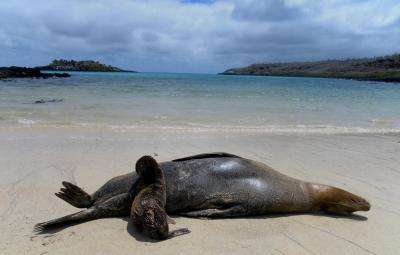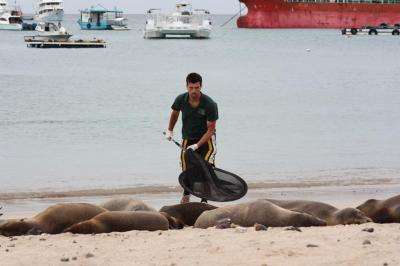Survival of the Galapagos sea lion

IMMUNE systems of endangered Galapagos sea lions are in overdrive because of harmful activity by people, reveal scientists from the Zoological Society of London (ZSL).
The study shows that Galapagos sea lions (Zalophus wollebaeki) are more prone to starvation because of exposure to human influences like pets and pollution. These can impair the level of their immunity, making them less able to hunt and more likely to go hungry when food is scarce.
This research is published today (28th June) in the journal PLOS ONE.
Conservationists spent more than eighteen months on the Islands of San Cristobal, which is inhabited by humans, and Santa Fe, where there are no humans, dogs, cats, mice or rats. They tagged 60 Galapagos sea lions from each island and monitored their behaviour and physiology.
ZSL's Institute of Zoology Director, Professor Tim Blackburn says: "We are increasingly aware of the threats of infectious diseases to wildlife around the world, from amphibians in the tropics to the birds in British gardens. It is worrying that we are now potentially seeing such threats to sea lions in the supposedly pristine wilderness of the Galapagos Islands."

ZSL's Dr. Paddy Brock, author on the paper, says: "A tell-tale sign of an unhealthy sea lion is a thinner than normal layer of blubber, which is what we saw in the sea lions on San Cristobal. This was all the more notable as we didn't notice these patterns in sea lions on Santa Fe, where they live without the presence of people or pets.
""The immune systems of San Cristobel sea lions were more active, perhaps indicating a threat of infectious disease, which could mean human activity is increasing the chance of potentially dangerous diseases emerging in the Galapagos sea lion," Dr Brock added.
Despite laws designed to protect the unique wildlife found on the Galapagos, pets are regularly imported to the islands, which increases the risk of new diseases arriving and spreading to local species. In addition, dumping of sewage into the bay on San Cristobal where the sea lions live may be increasing their exposure to germs and bacteria associated with humans.
ZSL, together with collaborators, will continue to address the threats faced by the Galapagos sea lion by carrying out further research into the methods driving the described patterns, such as the role that genetics plays in shaping them.
More information: PLoS ONE 8(6): e67132. doi:10.1371/journal.pone.0067132
Journal information: PLoS ONE
Provided by Zoological Society of London
















